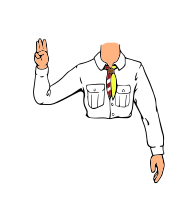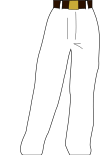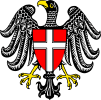Pfadfinder und Pfadfinderinnen Österreichs
| Pfadfinder und Pfadfinderinnen Österreichs | |||
|---|---|---|---|
|
Austrian Boy Scouts and Girl Guides | |||
| Country | Austria | ||
| Founded | 1976 | ||
| Membership | 21,000 | ||
| Präsident | Franz Stelzer | ||
| Vizepräsident | Dominik Habsburg-Lothringen | ||
| Vizepräsidentin | Susanna Hasenauer | ||
| Affiliation | World Association of Girl Guides and Girl Scouts, World Organization of the Scout Movement | ||
|
| |||
|
Website ppoe.at | |||

   | |||
Pfadfinder und Pfadfinderinnen Österreichs (PPÖ; Austrian Boy Scouts and Girl Guides) is the largest Scouting and Guiding organization in Austria and the only one approved by World Association of Girl Guides and Girl Scouts (WAGGGS) and the World Organization of the Scout Movement (WOSM). The association claims more than 300 troops (local units) with more than 85,000 Scouts nationwide. WOSM and WAGGGS give quite smaller membership values for the PPÖ: 9,503 Scouts (as of 2013)[1] and 10,508 Guides (as of 2003).
The badge of the PPÖ is dark red with a white combination of a fleur-de-lis and a trefoil, the symbols of WOSM and WAGGGS, respectively. In the center of the crest is a lighter red-and-white shield bearing the heraldic colors of Austria. The badges of both supranational organizations are also used. Male Scouts wear a blue WOSM logo on their uniforms, females wear a WAGGGS logo in the same position.
The association is member of the Austrian National Youth Council.
History
The first Austrian Scouting was founded in 1909 under Austria-Hungary. In 1910, the first Scout group - still in existence today - was founded in Wiener Neustadt. In 1912, Emmerich Teuber began the first Scout group in Vienna. The Catholic Church simultaneously founded the Pfadfinderkorps Sankt Georg. The first camps were held in 1913.
As the movement spread, Girl Guides joined in 1913 and troops were founded all over the country. The national organization, the Österreichischer Pfadfinderbund (ÖPB), was founded in April 1914. including the Girl Guide movement. This organization had strong ties to Magyar Cserkészszövetség and Junák, which was an independent Scout association in Bohemia. After World War I, Scouting developed separate organizations in Slovenia and in other areas of the fractured Habsburg Empire.
The ÖPB's programs expanded, including Cub Scouts in 1920 and Rovers in 1921. Austria's movement also gained international recognition as a founder member of WOSM during an international conference in 1922; it hosted another international conference in 1931 (in Baden bei Wien). The Girl Guides association grew more prominent with the foundation of the Österreichischer Pfadfinderinnenbund, which was part of the national organization and was led by Marie Antoinette Hofmann; this was followed by an independent girls association, formed in 1929, called Bund der Helferinnen. Austrian Scouts introduced the Mother's Day in Austria, first to honour the mother of the Bundespräsident.
In 1922 Catholic groups within the Österreichischer Pfadfinderbund united in the "Ring der St.Georgspfadfinder". In 1926 they left the Österreichischer Pfadfinderbund and founded the Österreichisches Pfadfinderkorps St.Georg, which also gained international recognition. In 1937 9,410 Scouts (ÖPB: 3,000, ÖPK St.Georg: 6,410) were registered in 1,025 troops.
Beginning in 1934, there was a non-Scouting youth organization run by the state, which provided competition for Austrian Scouts. With the arrival of the Nazis and World War II, however, Scouting in Austria was banned. In 1938, a number of Scout leaders were arrested and Scouting went underground, becoming associated with the Red Cross for example. At the first celebration of the end of World War II, there were Scouts in uniform on the streets. More than 800 Scouts and Scoutleaders left Austria in 1938. "Austrian Scouts in Great Britain" was the Austrian Scouts-in-Exile organisation. Between 1939 and 1945 "Der neue Weg" was published as Austrian Scout magazine in Exile.
The Boy Scouts were readmitted to WOSM in 1946. Following the way, the national organizations combined to form the Pfadfinder Österreichs, which hosted the 7th World Scout Jamboree in Bad Ischl in 1951 with 12,884 participants from 61 countries. In 1949 several Scoutleaders left the Pfadfinder Österreichs and founded the Österreichischer Pfadfinderbund again. In 1956 Austrian Scouts helped refugees after the Hungarian Revolution of 1956. Austrian Scouts celebrated the 26th of October as "Day of the Austrian Flag" for long years.
The first national Austrian jamboree occurred in 1961, and continued every ten years.
In October 1946 the Bund Österreichischer Pfadfinderinnen (BÖP) was founded in Vienna. Among the founder members was Charlotte Teuber-Weckersdorf. In 1948 the Catholic groups united in the Arbeitsgemeinschaft katholischer Gruppen im Bund Österreichischer Pfadfinderinnen (work group of Catholic groups of Bund Österreichischer Pfadfinderinnen). 1950 the Catholic groups left the "Bund Österreichischer Pfadfinderinnen" and founded the Östereichischer Pfadfinderinnenverband Sankt Georg (ÖPVSG). The Bund Österreichischer Pfadfinderinnen declined. In 1957, the ÖPVSG became an associate member of WAGGGS, receiving full member status in 1969.
The boys and girls associations were finally merged again in 1976, forming the modern Pfadfinder und Pfadfinderinnen Österreichs.
In 1995 the Pfadfinder und Pfadfinderinnen Österreichs and the Österreichischer Pfadfinderbund signed a cooperative agreement.
Celebrating the 100th birthday of the Scout Movement in Austria, a jubilee jamboree, named "urSPRUNG 2010 - Austrian Jubilee Jamboree", took place on the palace grounds of Laxenburg Castle in August 2010 (August 2–12).[2][3] The Austrian National Jamborees of 1936[4]:109 and 1961[4]:190 [5] also took place on the same grounds.
Divisions
There are nine geographical divisions of the PPÖ, one for each State of Austria. Every Scout wears the badge of his state on his uniform.
 Vorarlberg - cloth banner on a white field
Vorarlberg - cloth banner on a white field Tyrol - red eagle on a white field
Tyrol - red eagle on a white field Salzburg - red yellow lion on white
Salzburg - red yellow lion on white Upper Austria - red and white stripes with a yellow eagle on a black field
Upper Austria - red and white stripes with a yellow eagle on a black field Lower Austria - blue field with five yellow eagles
Lower Austria - blue field with five yellow eagles Styria - green field with a white panther
Styria - green field with a white panther Carinthia - white field with three red yellow lions on the left side
Carinthia - white field with three red yellow lions on the left side Burgenland - yellow field with a red eagle on a stone
Burgenland - yellow field with a red eagle on a stone Vienna - red with a white cross
Vienna - red with a white cross
Program
There are four age divisions of the PPÖ.
- Age 7 - 10 - Wichtel (girls; Brownies) and Wölflinge (boys; Cub Scouts)
- Age 10 - 13 - Guides (girls) and Späher (boys)
- Age 13 - 16 - Caravelles (girls) and Explorers (boys)
- Age 16 - 20 - Rangers (girls) and Rovers (boys, Rover Scouts)
Some troops have introduced a Biber division for children younger than 7, but that age division is not approved by the PPÖ.
Uniform

All members wear their group neckerchief. Wichtel and Wölflinge wear a royal blue T-shirt and/or sweatshirt with logo. All other ages wear a maroon shirt. However, for more physical activities, Guides/Späher can wear an official green T-shirt. Caravelles/Explorers can wear a navy blue version. Traditional wide brimmed Scout hats are a popular, optional choice.
Sea Scouts
There are Sea Scout groups in Hainburg an der Donau , Vienna , Villach , St. Georgen an der Gusen (the "Seepfadfinder" are part of the Scout group 4222 ) and Graz (the "Flusspfadfinder" are part of the Scout group Graz 5 Kalvarienberg ).
Peace Light of Bethlehem
The Peace Light of Bethlehem is a program inaugurated in Austria in 1986 as part of a charitable relief mission for handicapped children and people in need. It has gone to more than 20 countries in Europe, as well as the Americas.
In 2007 a delegation of Guides and Scouts from Austria, Germany, Israel, Jordan and the Palestinian National Authority together lighted the Peace Light in Bethlehem. Also in 2005 the International Commissioner of Austria Thomas Ertlthaler passed the Peace Light to a delegation of Guides and Scouts from the Palestinian National Authority under the leadership of Saed Shomali, the International Commissioner of the Palestinian Scout Association.
See also
References
- ↑ "WOSM MEMBERSHIP CENSUS 2013: Census as at 31 December 2013" (PDF). World Organization of the Scout Movement. Retrieved 2015-08-05.
- ↑ "urSPRUNG 2010-Austrian Jubilee Jamboree". Retrieved 2009-08-01.
- ↑ Heinz Wagner (2010-08-04). "100 Jahre Pfadfinder: Miteinander bauen, kochen, spielen". KURIER-Unabhängige Tageszeitung für Österreich (in German): 13.
- 1 2 Pribich, Kurt (2004). Logbuch der Pfadfinderverbände in Österreich (in German). Vienna: Pfadfinder-Gilde-Österreichs.
- ↑ Michael Holzmann. "urSPRUNG 2010 – der Countdown läuft ...". Boy Scouts and Girl Guides of Lower Austria. Retrieved 2009-08-01.
